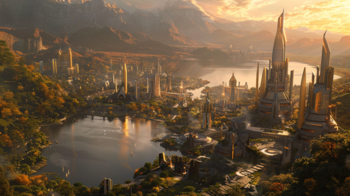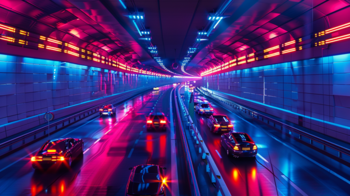Seclya: Difference between revisions
| (2 intermediate revisions by the same user not shown) | |||
| Line 155: | Line 155: | ||
===Energy=== | ===Energy=== | ||
[[File:Nuclear_Power_in_Seclya.jpg|350px|thumb|right|Nuclear power in Seclya provides much of the country's energy needs.]] Seclya’s energy grid is a mixture of various formats, with the country having invested heavily in green energy sources and renewables in the postwar years. As of 2024, more than seventy percent of the country’s energy production comes from nuclear power stations, making it one of the most robust nuclear energy grids in Gholgoth. The country increased its nuclear production to its current levels through investment in hypermodern reactor designs, boasting plants that can utilize nuclear waste in its reactors. Cold fusion technology has become a major priority for the country owing to the [[Ushya Accords]] which sets a target for nuclear fusion energy by the year 2045. Two research laboratories in Hela Thalas and Isyh Alora have produced small fusion reactions in their reactors, leading to the hope that the country will meet its fusion project deadline ahead of time. | [[File:Nuclear_Power_in_Seclya.jpg|350px|thumb|right|Nuclear power in Seclya provides much of the country's energy needs thanks to heavy government investment.]] Seclya’s energy grid is a mixture of various formats, with the country having invested heavily in green energy sources and renewables in the postwar years. As of 2024, more than seventy percent of the country’s energy production comes from nuclear power stations, making it one of the most robust nuclear energy grids in Gholgoth. The country increased its nuclear production to its current levels through investment in hypermodern reactor designs, boasting plants that can utilize nuclear waste in its reactors. Cold fusion technology has become a major priority for the country owing to the [[Ushya Accords]] which sets a target for nuclear fusion energy by the year 2045. Two research laboratories in Hela Thalas and Isyh Alora have produced small fusion reactions in their reactors, leading to the hope that the country will meet its fusion project deadline ahead of time. | ||
Twenty percent of the nation’s energy comes from geothermal energy thanks to its highly active geological resources, with the remaining ten percent coming from hydrothermal, natural gas, solar and wind energy. The country’s last oil and coal fired energy plants went offline in 2021 and 2023, respectively. The country is blessed with an abundance of oil and natural gas deposits, making it one of the region’s largest liquified natural gas and petroleum exporters. The country has set a target of 2050 to reach net zero emissions and to reduce GHC emissions by eighty percent by the year 2040. Owing to Amadorian support, Seclya has emerged from the postwar period as one of the greenest nations in Gholgoth. | Twenty percent of the nation’s energy comes from geothermal energy thanks to its highly active geological resources, with the remaining ten percent coming from hydrothermal, natural gas, solar and wind energy. The country’s last oil and coal fired energy plants went offline in 2021 and 2023, respectively. The country is blessed with an abundance of oil and natural gas deposits, making it one of the region’s largest liquified natural gas and petroleum exporters. The country has set a target of 2050 to reach net zero emissions and to reduce GHC emissions by eighty percent by the year 2040. Owing to Amadorian support, Seclya has emerged from the postwar period as one of the greenest nations in Gholgoth. | ||
===Transportation=== | ===Transportation=== | ||
The Saahein Sovereignty has spent much in the way of fiscal and materiel resources in rebuilding the country’s transportation grid following its victory over the Hakulic peoples in the War of the Leaves. With support from its Amadorian allies, the country has embarked on a massive public transportation spending spree along with conversion of its former wartime assets into civilian use infrastructure. Public transportation infrastructure accounted for nearly ten percent of discretionary spending by the government in 2024, owing to efforts to expand its airship infrastructure. Much of the public transportation networks have gone green, with electric vehicles and light rail networks contributing to the push for cleaner transportation technology. The country’s public transportation grid in totality boasts a seventy percent eco-friendly proportion, with the stated aim of raising that to full capacity by the year 2040. Municipal grid development has become a major government initiative in recent years. | |||
====Road Network==== | ====Road Network==== | ||
[[File:Underground_Highway_in_Seclya.png|350px|thumb|left|The Andrathath Larrel system provides highway services to Seclya.]] | [[File:Underground_Highway_in_Seclya.png|350px|thumb|left|The Andrathath Larrel system provides highway services to Seclya through underground connectors between cities.]] | ||
====Rail==== | ====Rail==== | ||
Revision as of 23:18, 25 June 2024
This article is incomplete because it is pending further input from participants, or it is a work-in-progress by one author. Please comment on this article's talk page to share your input, comments and questions. Note: To contribute to this article, you may need to seek help from the author(s) of this page. |
Saahein Sovereignty of Seclya Casariaat Saahein ria Seclya | |
|---|---|
| Motto: Dus Cresh Achait Vustarius Saahein Glory Eternal to the High Elves | |
| Anthem: Anareth Amorya | |
| Capital | Syva Aethel |
| Largest city | Haanathemar |
| Official languages | Saaheinic |
| Recognised national languages | Hakul |
| Ethnic groups |
|
| Demonym(s) | Seclyai |
| Government | Constitutional Monarchy |
• Ostrax | Ruven I Achax |
• Miax | Issarel Ermys |
| Legislature | Luwhein |
| History | |
• The First Saahein | Circa 25000 BCE |
• The Warring Tribes | 5000 BCE - 2500 BCE |
• Prisoners of the Hakul | 2500 BCE - 2000 CE |
• War of the Leaves | 2000 CE - 2005 CE |
• The Kingdom Age | 2005 CE - Present |
| Area | |
• Total | 5,551,400 km2 (2,143,400 sq mi) |
• Water (%) | 13.12% |
| Population | |
• 2024 census | 13,658,057,006 |
• Density | 118.54/km2 (307.0/sq mi) |
| GDP (nominal) | 2024 estimate |
• Total | $725.84 Trillion |
• Per capita | $53,143.84 |
| Gini | 25.325 low |
| HDI | 0.912 very high |
| Currency | Cresh (C) (CRS) |
| Date format | dd-mm-yy |
| Driving side | right |
| Internet TLD | .sec |
Seclya, officially the Saahein Sovereignty of Seclya (Saaheinic: Casariaat Saahein ria Seclya) is a Gothic Elven Kingdom ruled by the House of Rothilion-Ermys, situated across the south-central area of Gholgoth on the Tiamian Peninsula, south of Amador and Brewdomia. Ruling over a population of 13.6 billion citizens, the Sovereignty also lays claim to the Kritarchic Residuum in Varathron, though it has no functional control over said territory as of 2024. Headed by the duumvirate of Ostrax Ruven I Achax and his consort Issarel Rothilion-Ermys, the country juggles competing demands of its constituent races, the Saahein, Lashein, Lacerta and a small population of Stahd captives left over from its victory in the War of the Leaves against their former Hauklic masters. Most of its population resides in the south of the country, away from the harshness of the Marysia Mountains in the north. The capital city of Syva Aethel is also the country’s newest city, constructed by the elves after the conclusion of the war; its largest city is Haanathemar. It is one of the smallest nations in Gholgoth by population.
Seclya is a constitutional monarchy ruled by the Saahein, a race of elves who along with their Lashein cousins departed from Amador several millennia ago during the Amadorian expansion. The Saahein, like the native Lacerta population, were domineered into submission by the Hakulic and later Seclyai humans that would come to forge their own human empire in the land. Repressing their magical heritage, the Saahein would rise up with their Lashein and Lacerta allies during the War of the Leaves, overthrowing the yoke of their human captors and forming a high elvish kingdom in Seclya. The Royal Family of Seclya is formed by the marriage of an adopted son of Maeralya of Amador, Ruven Rothilion and the Amadorian Issarel Rothilion-Ermys. Part of the mission of the royal family is to pass down the newly released tradition of magic among the elves, along with creating a semi-autonomous partition for the Lacerta who sided with the elves during the war. Assisted by Amador, the country has rebounded from the war to become a highly-technological society of magic wielders.
The country has emerged from the war as a burgeoning center for the arts and sciences, with education becoming a central priority of the government. The highly centralized bureaucracy is dominated by its centerpiece organization, the Vulmar, its legislative body. Restoring the elves to their rightful highborn status, continuing the geological and ecological recovery from the war and contributing to a developing high-income economy are the chief concerns of the legislature and the government at large. The country sponsors numerous institutions of higher learning to help the elvish and lacertan population recover from the war and build a brighter future for themselves and their progeny. Despite its immense progress thanks to the Imperium Intervention during the war and its aftermath, Seclya in many ways remains a rebuilding nation trying to find its place among the Gothic north.
History
The Lacertan Hegemmony
The End of the Hegemony
Rise of the Hakul
The Early Clans
The Arrival of the Lashein and Saahein
Braedel and the Religion of Apocalypse
Braedelism Takes Hold
The Late Kingdom
The Seclyai Invasion
Braedel's Offspring
The Seclyai Formation
The Modern Order
The Freedom of the Hein
The Rise of the Stadh
The Creation of the Brean
The Human-Otherkin War
The War Begins to Turn
The Saahein Sovereignty
Geography
Climate
Biodiversity
Government
National
Subdivisions
Foreign Relations
Saahein-Amadorian Relations
Military
Law Enforcement
Demographics
Population
Religion
Largest Cities
Health
Education
Primary
Secondary
Tertiary
Arcane Universities
Culture
Symbols
Sports
Literature
Arts
Media
Influences
Amadorian Influence
Economy
Main article: Economy of the Saahein Sovereignty of Seclya
The economy of the Saahein Sovereignty is one of the most developed in Gholgoth, thanks in no small measure to the pre-war focus on economic strength by the Hakulic-Seclyai and their free market orthodoxy, which has been adapted by the new confederation of Sovereignty races into a highly articulated artisan economy. Assistance from the Kingdom of Amador in the form of trade agreements have also helped the new elvish economy recover greatly from the War of the Leaves. The country boasts a high standard of living with redistributive wealth policies to care for the poorest of the land. The Gross Domestic Product (GDP) is estimated at around $725.84 Trillion NSD, with a GDP Per Capita (Nominal) of $53,143.84 NSD. Seclya maintains an average compounded economic growth rate of 3.7% annually, and has seen its unemployment rate drop below 4% for the first time in 2024 since before the war. The highly specialized economy is one of the largest in Gholgoth.
Seclya possesses a mixed market economy with Elven characteristics, with a highly skilled labor force, relatively low levels of corruption, and a high level of technological innovation thanks to its ancient roots and the assistance in development by the Kingdom of Amador. The country’s central government operates as a dirigiste force on the economy as a whole, exerting regulatory oversight and redistributive policies to help spread capital throughout the economy and the population in general. The country’s citizens receive a universal basic income (UBI) to help meet basic needs, while certain inalienable rights like universal child and healthcare, free higher education and housing and nutritional assistance are held sacrosanct. The country is a net exporter of goods, though the trade surplus has begun shrinking in recent years as the explosive population growth has led to higher consumption and a greater market demand for goods. Seclya’s top exports include agriculture, artisan goods, forestry products, furniture, precious minerals, raw materials and an abundance of mineral resources like copper, lithium, and tin.
The Seclyai have one of the highest average household incomes in Gholgoth, with a high median household income thanks to efforts to reduce the wealth gap through redistributive economic policies. Income inequality has dropped by 2% year-on-end since the War of the Leaves, though a sizable wealth gap still remains thanks to the pre-war legacy of the market economy. The poverty rate hovers around 4% thanks to government interventions in healthcare, housing, education and food assistance. Food security is a highly prized government intervention thanks to the country’s agricultural output, strong agricultural subsidies and the social safety net. The large welfare state, backed by the strong Seclyai economy, guarantees paid vacation time, maternity and paternity leave, and compulsory health coverage through the state-owned healthcare system. Artisan guilds and trade unions have collective bargaining rights with their employers for better compensaiton packages.
Structure
Tourism
Infrastructure
Seclya possesses a unique infrastructure owing to its Hakulic past, with much of the country united by the military aims of the former Seclya Formation and thus possessing a robust infrastructure network designed to move large amounts of people and freight about in a secure and timely manner. The country is perhaps most known for its famous underground highways, large bored tunnels through bedrock that were originally purposed for military usage and have since become the nation’s main civilian highway infrastructure. Following its victory in the War of the Leaves, the Saahein Sovereignty adopted the Ifa Serine Protocol in developing a robust public transportation network in and around the nation’s cities. The engineering projects created through the use of elven labor and magicks are some of the largest in Gholgoth during the twenty-first century. Much help was derived from the Amadorian Imperium following the war in helping to rebuild a war torn society.
The nation’s geography has favored the development of water-based transportation through the usage of its navigable rivers and canals. As a major exporter of energy, minerals and raw materials, the country’s infrastructure is designed to extract resources from the interior and move them to the country’s major port facilities. Civilian traffic on the waterways has increased in recent years thanks to the country’s push to revitalize its green industry sector, lessening the emissions from the country’s overland road system. Air travel has become popular in the postwar years thanks to the Amadorian example of airship travel. Construction has commenced in most major cities for ‘sky ports’ for airships of varying sizes to accommodate long-distance travel between cities.
Energy
Seclya’s energy grid is a mixture of various formats, with the country having invested heavily in green energy sources and renewables in the postwar years. As of 2024, more than seventy percent of the country’s energy production comes from nuclear power stations, making it one of the most robust nuclear energy grids in Gholgoth. The country increased its nuclear production to its current levels through investment in hypermodern reactor designs, boasting plants that can utilize nuclear waste in its reactors. Cold fusion technology has become a major priority for the country owing to the Ushya Accords which sets a target for nuclear fusion energy by the year 2045. Two research laboratories in Hela Thalas and Isyh Alora have produced small fusion reactions in their reactors, leading to the hope that the country will meet its fusion project deadline ahead of time.
Twenty percent of the nation’s energy comes from geothermal energy thanks to its highly active geological resources, with the remaining ten percent coming from hydrothermal, natural gas, solar and wind energy. The country’s last oil and coal fired energy plants went offline in 2021 and 2023, respectively. The country is blessed with an abundance of oil and natural gas deposits, making it one of the region’s largest liquified natural gas and petroleum exporters. The country has set a target of 2050 to reach net zero emissions and to reduce GHC emissions by eighty percent by the year 2040. Owing to Amadorian support, Seclya has emerged from the postwar period as one of the greenest nations in Gholgoth.
Transportation
The Saahein Sovereignty has spent much in the way of fiscal and materiel resources in rebuilding the country’s transportation grid following its victory over the Hakulic peoples in the War of the Leaves. With support from its Amadorian allies, the country has embarked on a massive public transportation spending spree along with conversion of its former wartime assets into civilian use infrastructure. Public transportation infrastructure accounted for nearly ten percent of discretionary spending by the government in 2024, owing to efforts to expand its airship infrastructure. Much of the public transportation networks have gone green, with electric vehicles and light rail networks contributing to the push for cleaner transportation technology. The country’s public transportation grid in totality boasts a seventy percent eco-friendly proportion, with the stated aim of raising that to full capacity by the year 2040. Municipal grid development has become a major government initiative in recent years.




